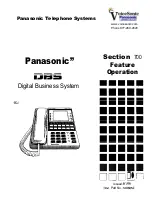
CONTENTS
4.1.14
is someone still in the group. Stations out of a group will not receive calls to that
group but will continue to receive calls to their individual extension numbers. When
desired, the user may put him/herself back into the group by pressing the button
again. Users who do not have this button may dial the access code and the group
desired. A station user is allowed to be in several groups, providing a key and the
extender of that group are assigned for each group on the user’s phone.
INCOMING CALL DISTRIBUTION
Incoming calls can be assigned to ring a distributed station hunt group. This allows
all members of the group to share the call load.
INCOMING/OUTGOING SERVICE
Outside lines are available for incoming or outgoing service. Programming allows
any outside line to be used for incoming calls only, outgoing calls only or both way
service.
INDIVIDUAL LINE CONTROL
Each station in the system can be individually programmed to allow or deny dialing
out as well as allow or deny answering for each outside line.
ISDN SERVICE
PRIMARY RATE INTERFACE (PRI)
The DCS 400si supports Primary Rate Interface ISDN. PRI allows simultaneous
data calls, calling party and calling line identification , high speed call setup and
disconnect are among the benefits if ISDN calling. The 23B+D configuration of
ISDN allows call information to be delivered via the data channel (the “D” of 23B+D)
thus leaving the bearer channels (the “B” of 23B+D) available for single use or
combined use to provide a wider bandwidth for data and video. The 400si supports
the most popular protocol standards in the U.S.
PRI Protocols supported:
National ISDN-2 (NI2),
AT&T No. 5 ESS Custom
DMS 100/250
BASIC RATE INTERFACE (BRI)
The DCS 400si BRI card supports trunk or station level Basic Rate Interface ser-
vices (BRI). Trunk or station BRI use is software programmable. BRI allows simul-
taneous data calls, called party and calling number identification, high speed call
setup and disconnect are among the benefits if ISDN calling. The 2B+D configura-
tion of ISDN allows call information to be delivered via the data channel (the “D” of
2B+D) thus leaving the bearer channels (the “B” of 2B+D) available for single use
or combined use to provide a wider bandwidth for data and video.
Summary of Contents for DCS 400SI
Page 1: ...CONTENTS ...
Page 5: ...1 1 DCS 400si GENERAL SYSTEM DIAGRAM CONTENTS ...
Page 28: ...CONTENTS 3 8 SYSTEM CALL CAPACITY BHCA 4 000 3 5 ...
Page 67: ...4 4 1 4 4 SAMPLE SMDR PRINTOUT WITHOUT CALLER ID CONTENTS ...
Page 68: ...4 5 1 4 5 SAMPLE SMDR PRINTOUT WITH CALLER ID AND CALL COST CONTENTS ...
















































